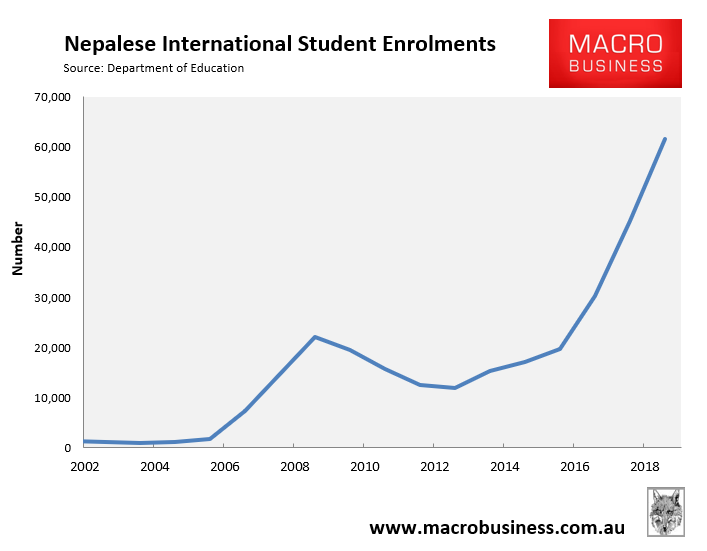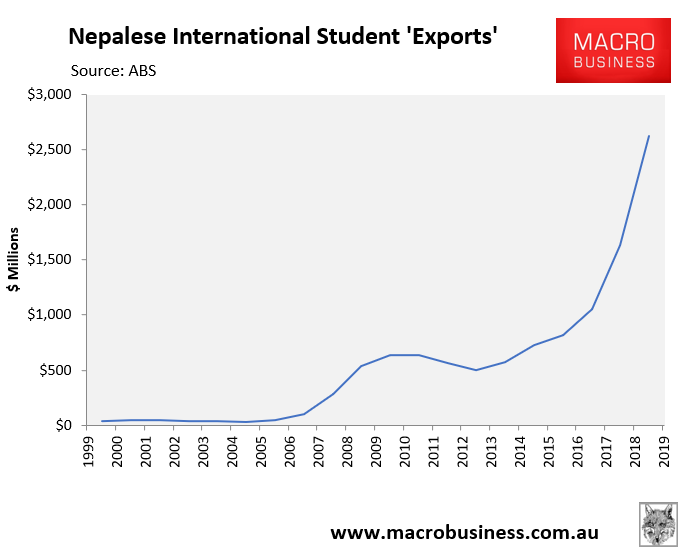In recent years, Nepal has emerged as Australia’s third largest source market for international students.
As shown in the next chart, the number of Nepalese students enrolled across Australian international education institutions ballooned from just under 12,000 in 2013 to 62,000 currently:

Over the same time period, ‘exports’ from Nepalese international students – comprising both fees paid and living expenses – skyrocketed from around $500,000 in 2013 to $2.6 billion in 2019:

This explosive growth in Nepalese students has led to accusations of exploitation by the education industry, with experts demanding urgent action from the federal government to close the rort down:
The number of education agents – or recruiters – operating in Nepal has leapt from a few hundred to more than 3000, according to a federal education department spokesman…
Unlike the Chinese and Indians, who mostly enrol in university degrees, about half the Nepalese students enrolled in vocational education and training or English language courses.
The trend has alarmed higher education experts, who warn it is unlikely the students can genuinely afford to study in Australia, and are likely involved in exploitative work to pay for their tuition.
Andrew Norton, professor of higher education policy at the Australian National University, said the Nepalese influx should be “red-flagged” by the Department of Home Affairs.
“Nepal is a country with a not-very-large population and it is very poor,” he said. “You have these basic questions of how so many people can afford to come to Australia and afford education here”…
Professor Norton said Nepalese international students had “an extremely high number” of secondary applicants on their visas, “suggesting to me that maybe they’re bringing in their spouses to work”…
Salvatore Babones, associate professor at the University of Sydney, was even more critical, accusing universities and the government of presiding over the “abuse” of poor families.
World Bank figures show Nepal’s gross domestic product per capita is about $US1000 – less than a 50th of Australia’s and half of India’s. “And yet it has this enormous contingent of students in Australia,” said Associate Professor Babones.
“This should be a red flag for everybody that they’re coming to Australia on loan-shark money, working their hearts out while they’re here in both legal and illegal employment so they can send money back to their families.
“The picture is so damning. I think the universities and the government should exercise more of a duty of care to poor people in a developing country rather than just take their money because it’s easy money. For Nepal, it’s just abusive.”
We’ve been here before. Mid last year, Inside Story’s Tim Colebatch warned on the torrent of low quality Nepalese students inundating Australia’s educational institutions:
…one source stands out: the little Himalayan country of Nepal, just thirty million people, living in one of Asia’s poorest countries.
In 2017–18, one in every 1500 inhabitants of Nepal emigrated to Australia. In an era of strict immigration controls, that is an astonishing number for two countries so far apart, with no common language, heritage or ethnicity.
Over the five years to mid 2018, one in every 500 Nepalis emigrated to Australia — and that’s in net terms, after deducting those who returned. In 2017–18, little Nepal became Australia’s third largest source of migrants after India and China…
Deregulation has allowed universities to selectively lower their standards to bring in more fee-paying foreign students, even when they fail to meet the thresholds for English language skills or academic achievement…
This is not the first time immigration from Nepal has surged. A decade ago, we saw a scam with training visas, in which “students” from India and Nepal came for training courses in Australia, then quickly vanished into the workforce. The scam saw net immigration set record levels in 2008–09, before then immigration minister Chris Evans shut it down. But most of those who came stayed on here.
At the current pace of immigration, Australia will soon have more residents born in Nepal than in Greece.
The explosive growth in international student numbers has already destroyed teaching standards, has inundated Australia’s labour market with cheap exploitative labour, and has helped crush-load Australia’s major cities.
The situation will only worsen as Australia’s educational institutions continue to pivot toward lower quality students from the Indian subcontinent in a desperate attempt to keep the fees flowing in.

